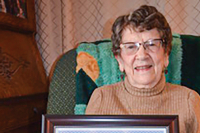Exploring the legacy of Ayn Rand
In Ayn Rand and the World She Made (ISBN 978-0-385-51399-9, Doubleday, 568 pages, $35), Anne C. Heller has given readers an intimate look at the woman who wrote such novels as The Fountainhead and Atlas Shrugged, works which had a great impact not only on the lives of hundreds of thousands of ordinary readers, but on certain major policy makers of the last 50 years.
Born in Czarist Russia in 1905, Rand grew up in a time of turmoil, war, and revolution. She and those around her — she lived in a tight-knit Jewish community in St. Petersburg — suffered, like so many people, when the Bolsheviks captured the Revolution and turned the country into a Communist dictatorship. Some of her friends fled the country, both during the war and during the revolutionary period, and Rand, though her immediate family all stayed behind, also departed at the age of 21 for the United States.
Even then she despised both statism and religion. Her heroes were Aristotle, Victor Hugo, the fathers of the American Revolution, and herself. In the next two decades, Rand quite literally willed herself to become a major novelist. After a short stay with relatives in Chicago, she found a job reading, editing, and then writing screenplays in Hollywood. She married a minor actor, Frank O’Connor, in part at least because he fit her notion of how an ideal man should look. While she and her husband scrabbled to make a living during the Depression — O’Connor had little ambition and would eventually become a stay-at-home husband, content to take care of the chores — Rand always kept her eyes on the goal she had set for herself: to become a major, best-selling novelist whose ideas might help change the world.
Eventually, of course, Rand achieved that goal. In We The Living, Anthem, The Fountainhead, and Atlas Shrugged, she found recognition, money, and an outlet for her ideas. From the late 1950s on, she received hundreds of letters each month from fans wanting to know more about this woman who had made selfishness and individualism the highest standards for human beings. By the time of her death in 1982, Ayn Rand possessed an enormous readership and had exerted a major influence on certain key figures of the Reagan administration. When Allen Greenspan was sworn in as the chairman of President Gerald Ford’s Council of Economic Advisers, Rand was there with him in the Oval Office, clearly proud of her protégé.
Heller, who is not always in agreement with Rand’s ideas, but who nonetheless does a fine job of presenting them objectively and fairly, combines her analysis of Rand’s writing with a vivid portrayal of Rand’s personal life. Here we see that Rand, like so many people, was often a farrago of contradictions. Her own male protagonists, for example, are heroic and filled with sex — Howard Roark in The Fountainhead dominates and essentially rapes Dominique Francon — whereas Frank O’Connor was mild and so non-aggressive sexually that Rand would eventually take a younger man, Nathaniel Brandon, for her lover, with the consent of her husband.
Rand also strongly emphasized logic and reason as the highest goals of man. Yet as she grew older, and as the cult of followers surrounding her grew, she often gave way to bouts of histrionics regarding the behavior and beliefs of those followers. Those who disagreed with her, those who veered in any way from the philosophy which she called Objectivisim, were banished from the group. She espoused the virtues of the mind, yet her own emotions in regard to her long affair with Brandon was often a rollercoaster of arguments and accusations.
Related Items
Like Ernest Hemingway, Rand was helped along the ladder to success by friends, family, and other writers. Like Hemingway, her usual response to such assistance, once she had reached the next rung of the ladder, was to give a boot in the face to those who had given her the boost. Her Chicago relatives, the family she left behind in Russia, those friends who ignited her intellectual ire, her literary mentors like Isabel Patterson: all were eventually ignored or brushed aside.
Yet even her political enemies admitted that Rand did possess a personal charm when she chose to exert it. One of her friends in the publishing world delighted in introducing his big-government friends to Rand, who would frequently surprised them by her questions and by her quick mind.
In the preface to this biography, Heller points out that Rand’s “novels and the best of her essays are well worth reading now, when issues of wealth and poverty, state power and autonomy, and security and freedom still disturb us.” It is a mark of the power of these novels that they are rarely taught in the universities, yet they each year attract new readers, mostly the young. The economic crisis of the last three years, for example, has nearly tripled the sales of Atlas Shrugged.
Heller’s story of Ayn Rand should stand as a fine example of biography. She has given us a major work about a woman whose ideas continue to make themselves felt in the political and economic arenas.









